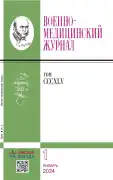Application of low-frequency pulsed electrostatic field for dorsalgia on an outpatient basis
- Authors: Iosifova О.А.1, Novozhilov A.S.1, Egorova О.L.1
-
Affiliations:
- 9th Treatment and Diagnostic Center of the Ministry of Defense of the Russian Federation
- Issue: Vol 345, No 1 (2024)
- Pages: 68-71
- Section: Brief articles
- URL: https://journals.eco-vector.com/0026-9050/article/view/627345
- DOI: https://doi.org/10.52424/00269050_2024_345_1_68
- ID: 627345
Cite item
Abstract
Comparative data on the treatment of dorsalgia in the physiotherapy department are presented. Under observation were 42 patients who were treated with the Hivamat 200 device both as the main therapeutic effect and in various combinations with other methods of physiotherapy. In the control group of patients (31 people), other methods of electrotherapy were used to relieve pain syndromes. It was revealed that in all cases of use for dorsalgia, the Hivamat 200 device showed quite high efficiency in relieving pain, especially in patients with radicular and myofascial syndromes, where an expansion of the coverage area of the therapeutic effect is required.
Full Text
About the authors
О. А. Iosifova
9th Treatment and Diagnostic Center of the Ministry of Defense of the Russian Federation
Author for correspondence.
Email: novozhilovdoc@mail.ru
Russian Federation, Moscow
A. S. Novozhilov
9th Treatment and Diagnostic Center of the Ministry of Defense of the Russian Federation
Email: novozhilovdoc@mail.ru
Russian Federation, Moscow
О. L. Egorova
9th Treatment and Diagnostic Center of the Ministry of Defense of the Russian Federation
Email: novozhilovdoc@mail.ru
Russian Federation, Moscow
References
- Дамулин И.В. Боли в спине: диагностические и терапевтические аспекты. – М.: РКИ Соверопресс, 2008. – 40 с.
- Камчатнов П.Р. Современные подходы к ведению больных с болью в спине // Concilium medicum. – 2004. – Т. 6, № 8. – С. 557–560.
- Куликов А. Г., Ярустовская О.В., Кузовлева Е.В. и др. Применение низкочастотного электрического поля в клинической практике // Физиотерапия, бальнеология и реабилитация. – 2019. – Т. 18, № 3. – С. 195–209.
- Парфенов В.А., Яхно Н.Н., Кукушкин М.Л. и др. Острая неспецифическая (скелетно- мышечная) поясничная боль: Рекомендации Российского общества по изучению боли (РОИБ) // Неврол., нейропсихиатр., психосоматика. – 2018. – Т. 10, № 2. – С. 4–11.
- Chapman J.R., Norvell D.C., Hermsmeyer J.T. et al. Evaluating common outcomes for measuring treatment success for chronic low back pain // Spine. – 2011. – Vol. 36, N 21S. – P. S54–S68.
- Global Burden of Disease Study 2013 Collaborators. Global, regional, and national incidence, prevalence, and years lived with disability for 301 acute and chronic diseases and injuries in 188 countries, 1990–2013: a systematic analysis for the Global Burden of Disease Study 2013 // Lancet. – 2015. – Vol. 386, Iss. 9995. – P. 743–800.
- Juniper M., Le T.K., Mladsi D. The epidemiology, economic burden, and pharmacological treatment of chronic low back pain in France, Germany, Italy, Spain and the UK: a literature–based review // Expert Opin. Pharmacother. – 2009. – Vol. 10, Iss. 16. – P. 2581–2592.
Supplementary files






